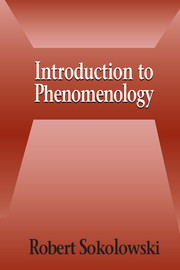Book contents
- Frontmatter
- Contents
- Acknowledgments
- Introduction
- 1 What Is Intentionality, and Why Is It Important?
- 2 Perception of a Cube as a Paradigm of Conscious Experience
- 3 Three Formal Structures in Phenomenology
- 4 An Initial Statement of What Phenomenology Is
- 5 Perception, Memory, and Imagination
- 6 Words, Pictures, and Symbols
- 7 Categorial Intentions and Objects
- 8 Phenomenology of the Self
- 9 Temporality
- 10 The Life World and Intersubjectivity
- 11 Reason, Truth, and Evidence
- 12 Eidetic Intuition
- 13 Phenomenology Defined
- 14 Phenomenology in the Present Historical Context
- Appendix: Phenomenology in the Last One Hundred Years
- Select Bibliography
- Index
2 - Perception of a Cube as a Paradigm of Conscious Experience
Published online by Cambridge University Press: 05 June 2012
- Frontmatter
- Contents
- Acknowledgments
- Introduction
- 1 What Is Intentionality, and Why Is It Important?
- 2 Perception of a Cube as a Paradigm of Conscious Experience
- 3 Three Formal Structures in Phenomenology
- 4 An Initial Statement of What Phenomenology Is
- 5 Perception, Memory, and Imagination
- 6 Words, Pictures, and Symbols
- 7 Categorial Intentions and Objects
- 8 Phenomenology of the Self
- 9 Temporality
- 10 The Life World and Intersubjectivity
- 11 Reason, Truth, and Evidence
- 12 Eidetic Intuition
- 13 Phenomenology Defined
- 14 Phenomenology in the Present Historical Context
- Appendix: Phenomenology in the Last One Hundred Years
- Select Bibliography
- Index
Summary
We will use a simple example to illustrate the kind of descriptive analysis of consciousness that phenomenology offers us. This example will give us an idea of the type of philosophical explanation that phenomenology provides. It will serve as a model for the more complicated analyses that we will undertake later.
SIDES, ASPECTS, AND PROFILES
Consider the way in which we perceive a material object, such as a cube. I see the cube from one angle, from one perspective. I cannot see the cube from all sides at once. It is essential to the experience of a cube that the perception be partial, with only one part of the object being directly given at any moment. However, it is not the case that I only experience the sides that are visible from my present viewpoint. As I see those sides, I also intend, I cointend, the sides that are hidden. I see more than what strikes the eye. The presently visible sides are surrounded by a halo of potentially visible but actually absent sides. These other sides are given, but given precisely as absent. They too are part of what I experience.
Let us formulate this structure in regard to its objective and its subjective dimensions. Objectively, what is given to me when I see a cube is a blend made up of sides that are present and sides that are absent but cointended. The thing being seen involves a mixture of the present and the absent. Subjectively, my perception, my viewing, is a blend made up of filled and empty intentions.
- Type
- Chapter
- Information
- Introduction to Phenomenology , pp. 17 - 21Publisher: Cambridge University PressPrint publication year: 1999



